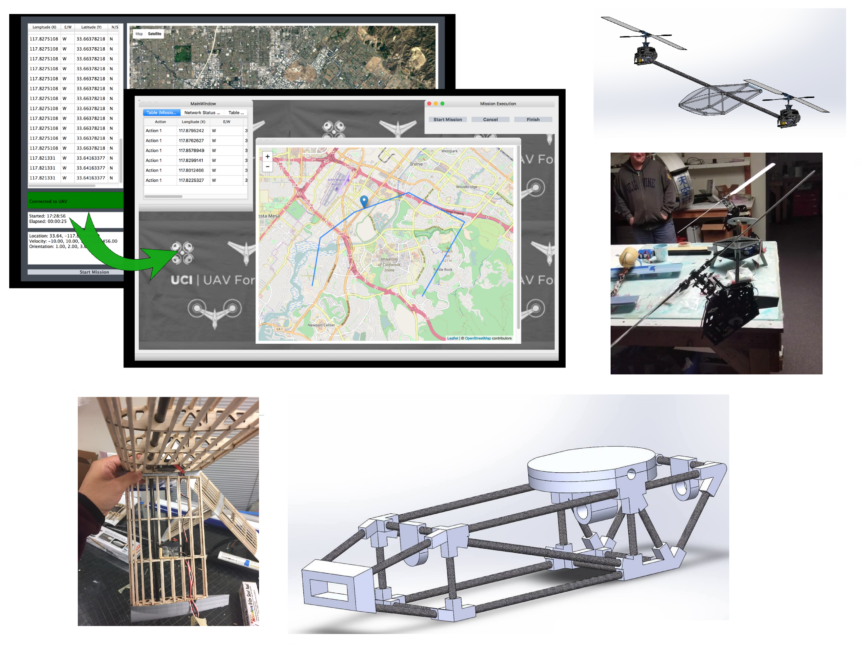With final exams chasing our heels, UAV Forge wraps it up for the year. Here are the last tasks the teams have completed and their goals for next quarter.
The Propulsion team has nearly completed a prototype structure of the tilt rotor set up. They have confirmed that the tandem software for the tilt rotor controller is working, but the controller needs tuning and a full functional, stable power source because the electronics dies after a few seconds of operating. Propulsion team is running experiments with the AVL program and has modeled the plane as a Boeing 787 with tilt rotors but the program is having trouble the reading code they created. For Winter 2016, the team will work with Avionics to integrate the sonar with the quad-copter, configure the tandem controller, test fly the prototype, and continue building the tilt rotor with Fabrication team.
Mechanical Design has finished building a smaller version of the frame to be put inside the tilt rotor prototype. Also, the final version of the plane’s frame is completed. The new frame involves a more flexible and simplified design of the joints so that future teams can easily edit the parts to accommodate any design changes. In the next quarter, the team will prepare the frame for simulation tests. The team will be working closely with Fabrication to resolve any manufacturing issues from the CAD design.
Fabrication team worked on attaching servos and applying monokote film onto the newest tail. For Winter 2016, the team’s goals are to increase production rate time of building the prototypes and improve their work quality. They want their members to become more familiarized with all fabrication processes in hopes of reducing manufacturing mistakes.
Ground Station summarizes their Fall 2016 accomplishments. They have revived the flight simulator and produced an outline of a formal protocol spec with Avionics. They also revamped the GUI with a new single-window design and replaced the Google Maps layout with Leaflet and they have completed the database interface code for the SQL Features, the functions that save and write files on the computer’s disk. Ground Station’s goals for next quarter are to implement the new features they’ve created in Fall 2016, which all aim towards finishing the Mission Recap functionality of the program. The New GUI will include a Mission Recap, the SQL will have the saving and loading missions function, and the network protocol will show mission tests with the flight simulator.
In the Avionics team, the Software and Hardware division have worked very hard to complete their tasks. It is important to note that during Winter 2016, only the Hardware division of Avionics is in operation because the Avionics is transitioning into a research phase, where the members are converted to test the plane’s hardware.
This quarter, the Software division has worked on the servo connection software that assisted in the sensor integration of the gyro, compass, and current monitor. They also found a new Lidar and Altimeter sensor and tested the radio controller-Arduino connection. The Software’s Winter 2016 goals are to integrate the new Lidar and Altimeter sensors, improve the Pixhawk-Arduino connection, establish code aggregation of loading all modules onto Arduino via one sketch, and to collaborate with Propulsion to learn about the control laws for obstacle avoidance system. Then, Hardware division has created a power supply/electronics layout for quad-copter (the device we use to test our sensors) and the tilt rotor. They also designed a servo power layout using a voltage regulator. Hardware researched and purchases components of the demo board and prototype their design using EAGLE CAD. Hardware’s next Quarter Goals are to Create and update electronics layout for tilt rotor and redistribute member tasks based on relevance and priority.
And finally, the project manager Cheng has assigned paired teams to work together based on common goals as mentioned in each team description above. Also, during our meeting, many of our members expressed their desire to stay in the project for another quarter, therefore, winter recruitment seems small for those interested in joining us.
Thank you for following us this quarter, happy holidays and see you next year!

